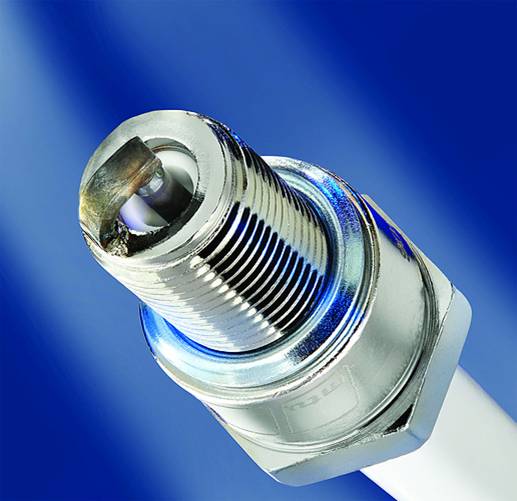 优选材料和最大电极面积,使辉门动力系统的新型M18冷塞具备了更强的抗火花腐蚀和化学腐蚀能力。(图片来源:辉门)
优选材料和最大电极面积,使辉门动力系统的新型M18冷塞具备了更强的抗火花腐蚀和化学腐蚀能力。(图片来源:辉门) “由于系统和组件技术的进步,米勒或阿特金森循环及高汽缸压(气体燃料发动机)等先进的燃烧策略能够实现与柴油机类似的热效率,”辉门动力系统的首席技术官Gian Maria Olivetti说。
“由于系统和组件技术的进步,米勒或阿特金森循环及高汽缸压(气体燃料发动机)等先进的燃烧策略能够实现与柴油机类似的热效率,”辉门动力系统的首席技术官Gian Maria Olivetti说。 辉门的新型Pokal工业火花塞在绝缘体上设置了U型芯,从而实现了前所未有的机械和电气性能。(图片来源:辉门)
辉门的新型Pokal工业火花塞在绝缘体上设置了U型芯,从而实现了前所未有的机械和电气性能。(图片来源:辉门)
环境压力和总拥有成本的考量,开始加速影响非公路车所采用的发动机类型。非公路设备行业包括许多小众市场,比如固定式发电设备发动机(包括热电联产应用和天然气泵),以及用于海运、铁路运输、建筑和采矿设备的发动机等。市场在过去大多选择柴油动力,但一些因素导致部分客户开始转向天然气燃料发动机,这就产生了对点火技术的需求。辉门动力系统已经开发出了能够满足新一代发动机特定需求的火花塞技术。
柴油发动机面临的压力
柴油发动机在若干方面正面临着越来越大的压力。减排要求使得非公路设备所用的柴油发动机变得更加昂贵,由于需要满足氮氧化物和颗粒排放的强制性法规要求,越来越复杂的燃烧控制和后处理成为必备技术。与此同时,设备运营者和车队所有者出于成本压力,需要进一步减少燃料消耗、并延长维修间隔期。
多年来,天然气一直是众所周知的环保型燃料,但在效率方面,气体燃料发动机始终无法与柴油发动机相媲美。如今,系统和组件技术的进步使得米勒或阿特金森循环及高汽缸压等先进的燃烧策略得以应用,使发动机能够实现与柴油机接近的热效率。
虽然柴油发动机仍占主导地位,但在许多领域已经出现了向天然气和其他替代气体燃料发动机转移的趋势,比如开始采用柴油和天然气双燃料发动机。在商业经济性适合的领域,设备运营方已经完成了向全火花点火技术的过渡,比如在天然气供应充足的条件下作业的船舶系统。未来10年,我们预计在北欧地区、澳大利亚和北美沿海地区,船舶系统将迎来快速发展,但海上燃料加注仍然面临挑战,这可能会限制洲际运输应用的潜力。
除了经济因素的考量外,基础设施条件也会影响燃料的选择。对于发电应用来说,生产现场通常有非常充足的天然气供应;而与此不同的是,铁路运输和采矿业应用的基础设施发展并没有十分成熟。采矿现场并没有可用燃料,所以必须不断进行燃料运输和补给,而对于铁路运输应用来说,只有一两节车厢能够携带运行大型火车所需的气体燃料。
天然气发动机的设计挑战
因地质条件和燃料来源不同,天然气或替代气体燃料种类繁多,在成分上有很大的差异,而燃料构成又对燃烧有着重大影响,从而影响火花塞的设计。例如沼气和生物燃气,虽然主要成分甲烷没有污染,但即便经过脱硫处理,其成分仍含有大量的硫化氢,在燃烧过程中易形成高腐蚀性化合物。这就需要优化火花塞设计,如从铂转为铱电极材料,从而实现更高的耐蚀性。
最新的发动机设计提高了效率、降低了排放和燃料消耗,但这些优化本身却为火花塞设计带来了挑战。为了减少氮氧化物排放、降低燃料消耗,空燃比要求即将提高至2.0λ;这些超稀混合物的充分燃烧,需要湍流预燃条件以及较高的汽缸压力。J-plug设计等老式的火花塞技术不能有效地处理如此高强度的湍流——气体可能会像吹灭蜡烛一样熄灭火花。由于点火时的气缸压力和流动能上升到了新水平,我们也需要提高点火能量来保证持续点火,以实现燃烧。
更为积极的新燃烧策略也推动了对多重点火、高能量输出的高级点火系统的需求。两至三次的多重点火模式可加快燃烧并提高效率,但同时也增加了电极腐蚀。相比于单次点火的一次腐蚀,多重点火和更长的火花持续时间不仅增加了点火次数,每次点火的腐蚀度也会更高。我们在实验室利用台架试验模拟了不同的点火模式及其特点,研究对电极材料的影响并制定合适的解决方案。
不同的工作循环对火花塞设计也有很大影响。发电设备所用的发动机需要在稳定负载下长时间运转;但在轮渡或拖船等运输应用中,发动机将在满载和无负载工况之间交替运行,循环疲劳可能导致另一种失效模式的出现。
天然气发动机的独特解决方案
高电压需求、汽缸内压力和温度升高、进气口湍流现象的出现,以及较长的使用寿命要求,都对火花塞设计提出了挑战、激发了新技术的发展,从而带来产品设计和制造工艺的进步,如选择最佳的零部件几何形状、基础金属和贵金属含量的配比等,最终开发出适用于火花塞尺寸和应用的最佳解决方案。
相比于发电设备发动机火花塞(M18螺纹),运输设备发动机通常使用较小的火花塞(M14螺纹),因为较小的横截面能够更好地应对强度、介质材料和耐久性方面的挑战,也推动了增强材料和独特电极设计的发展。
为了提高点火效果,辉门动力系统在电极周围增加了屏蔽装置,例如在环形间隙中加入环形电极,以降低燃烧点火时火花熄灭的风险。另一种点燃超稀混合物的方法是使用预燃室火花塞,点火时用封闭的盖子来改善火花隙附近的混合物和流动条件。在预燃室内成功启动点火装置后,火焰会通过喷流进入主燃烧室。火焰携带着超高能量源,在实现可靠点火的同时可确保最高燃烧效率和最低氮氧化物排放。
另一个解决天然气相关挑战的具体技术,是辉门动力系统专门为14毫米应用而设计的Pokal火花塞。随着发动机越来越接近爆震边缘,我们开发了一种独特的陶瓷几何绝缘层,以抵抗在这些条件下运行带来的负荷。传统绝缘层的锥形头限制了火花塞的热量范围和热电性能。Pokal火花塞的头部在中央电极周围有一个杯型腔,可以同时改善电气强度和机械强度,尤其是后者。该设计使火花塞能够更好地承受高电压,确保在汽缸压力峰值或异常燃烧条件下的安全操作。
为了在18毫米的预燃室燃料发动机中降低电极温度、抵抗腐蚀,我们开发了“冷塞”技术,这一解决方案可将接地电极温度降低200°C(360°F)以上。在23巴(334 psi)BMEP以上的预燃室燃气发动机中,“冷塞”可生成超大的火花表面积,使用寿命最高达到标准铱材料J-gap火花塞的四倍。为了确保电极耐久性,我们成功地突破了制造工艺上的挑战,通过专门的激光焊接技术实现了镍合金与铱-铑合金的结合。
以上成果展示了辉门动力系统为应对行业挑战所作的努力。作为全球OEM基础发动机组件技术的主要供应商,我们了解客户面临的商业和监管压力,并坚持不懈地致力于开发创新型技术,为客户提供具有成本效益的解决方案,帮助客户应对技术挑战。
本文作者是辉门动力系统公司的首席技术官Gian Maria Olivetti,文章属于《卡车与非公路工程》“高管视角(Executive Viewpoints)”年度系列报道的一部分。
Environmental pressures and total cost of ownership are beginning to change the types of engines used for off-highway applications, and this trend is likely to accelerate. The off-highway sector includes many niche markets, such as stationary engines for power generation including combined heat-power applications, natural gas pumping, and transit engines for marine, rail, construction and mining applications. Historically, the preferred choice for most of these has been diesel power, but a combination of factors is leading some to switch to natural gas-fueled engines, requiring spark ignition. Federal-Mogul Powertrain has developed a number of spark plug technologies that meet the specific needs of this new generation of engines.
Pressures on diesel engines
Diesel engines face growing pressures on several fronts. Emissions reduction is making diesel engines more expensive in many of the off-highway sectors because increasingly sophisticated combustion control, allied to more complex aftertreatment, is becoming necessary to meet the mandatory limits for NOx and particulate emissions. At the same time, cost pressures on operators and fleet owners mean demand continues for further reductions in fuel consumption and extended intervals between servicing.
Natural gas has been well-known as an environmentally friendly fuel for many years, but gaseous-fueled engines have traditionally been unable to match the efficiency of diesels. Now that advances in system and component technologies enable advanced combustion strategies like Miller or Atkinson cycles and higher cylinder pressures, they can reach a thermal efficiency closer to a diesel.
While diesel engines still remain dominant, in many sectors a migration to natural gas and other alternative gaseous fuels began with the use of dual-fuel engines able to run on diesel and gas. Some operators have already completed the transition to full spark ignition operation where the business economics support the change, such as marine systems operating at a site with a plentiful gas supply. We anticipate rapid growth in marine in the next 10 years in the coastal regions of Scandinavia, Australia and North America, but the challenge of mid-ocean refueling is likely to limit the potential for inter-continental applications.
Beside economic considerations, infrastructure requirements also influence the choice of fuel. For power generation applications, there is often an unlimited natural gas supply on-site; for rail transport and mining applications, the infrastructure is less mature in its development. With mining, there is no fuel available onsite, so it must be transported and refilled constantly, while for rail applications, only one or two railroad cars can carry the gas needed to operate a large train.
The challenges of designing for natural gas
Natural gas or alternative gaseous fuels include a wide range of variations from different geological regions and derived from alternative sources, leading to considerable differences in composition that can have a major influence on combustion and consequently on spark plug design. For example, while the main constituent, methane, is very clean, some of the compositions of digester gas or biogas contain significant hydrogen sulphide levels even after sulphur scrubbing, from which highly corrosive compounds are formed during the combustion process. This necessitates design changes on spark plugs, such as switching from Platinum to Iridium electrode materials for greater corrosion resistance.
The higher efficiency, lower emissions and reduced fuel consumption of the latest engine designs have been achieved through various measures that, in themselves, create challenges for the spark plug. To reduce NOx and fuel consumption, air:fuel ratios as high as Lambda 2.0 are being introduced; satisfactory combustion of these ultra-lean mixtures requires turbulent pre-combustion conditions combined with higher in-cylinder pressures. Older plug technology such as J-plug designs do not work effectively with such high levels of turbulence—akin to blowing out a candle. As cylinder pressures and turbulent kinetic energy rise to new levels at the time of ignition, we also need higher ignition energy to ensure consistent combustion initiation.
New, more aggressive combustion strategies also drive the need for advanced ignition systems featuring multi-strike modes and high energy output. A two- or three-strike ignition mode produces faster combustion and better efficiency, but increases erosion of the electrodes. Whereas a single strike creates a single erosion event, multiple strikes combined with longer spark duration cause several events with higher erosion rates per event. We simulate in the laboratory the different ignition modes and their characteristics using rig tests, in order to investigate their effect on electrode materials and to develop suitable solutions.
Differences in the duty cycles for alternative applications have a major impact on spark plug design as well. An engine used for power generation will operate for prolonged periods at a steady load; a transit application, such as a ferry or tugboat, will alternate between full-load and no-load running much more often. This introduces another potential failure mode through cyclic fatigue.
Unique solutions for natural gas operation
The combined effects of higher voltage demands, increased in-cylinder pressures/temperatures and turbulent charge flow conditions, coupled with longer service life requirements, presents challenges to spark plug design and stimulates the evolution of new technologies. This has enabled developments in both product design and manufacturing processes, including the choice of physical geometry, base metallurgy and precious metal content, with optimum solutions tailored to the size of the plug and to the application.
The engines for transit applications typically use smaller plugs (M14 thread) than the power generation sector (M18 thread), which subjects the plug to greater challenges of strength, dielectric and durability because of the inherently smaller cross sections. This drives the development of enhanced materials and unique electrode designs.
To increase ignitability, Federal-Mogul Powertrain has added inherent shielding around the electrodes, such as an annular gap with a ring electrode to reduce the risk of spark blow-out during combustion initiation. Another means of igniting ultra-lean mixtures is the use of a pre-chamber type plug with an enclosed cap to optimize mixture and flow condition around the spark gap at time of ignition. Successful initiation of ignition in the pre-chamber results in flame torches blowing over via jets into the main combustion chamber. These torches carry an ultra-high energy source, allowing for reliable ignition, which results in highest efficiency and lowest NOx.
Another good example of a specific technology that addresses natural gas-related challenges is Federal-Mogul Powertrain’s Pokal plug, specifically designed for 14-mm applications. As engine manufacturers are pushing combustion closer and more frequently towards the knock threshold, we developed a unique ceramic insulator geometry to resist the loads associated with operating under these conditions. Conventional insulators have a conical nose, the shape of which defines the heat range of the plug and ultimately limits the thermal and electrical properties. The nose of the Pokal spark plug incorporates a cup-shaped cavity around the center electrode, improving both the electrical and especially mechanical strength. This shape allows the plug to better withstand increased voltage demands and allows for safe operation under high peak cylinder pressure or abnormal combustion conditions.
To reduce electrode temperatures and resist erosion in the 18-mm size for fuel-fed pre-chamber engines, our “cold” plug technology is a solution which reduces ground electrode temperatures by more than 200°C (360°F). It produces an exceptionally large spark surface area and provides up to four times the service life of a standard iridium J-gap spark plug in active pre-chamber gaseous-fueled engines operating at over 23 bar (334 psi) BMEP. To ensure the required electrode durability, we applied our specialized laser welding technology, which enables the combination of nickel alloys with iridium-rhodium alloys that would normally present significant manufacturing challenges.
These developments illustrate Federal-Mogul Powertrain’s approach to the industry’s challenges. As a leading supplier of base engine component technology to the world’s OEMs, we understand the commercial and regulatory pressures facing our customers and continue to focus on innovative technologies that provide cost-effective solutions to their challenges.
Gian Maria Olivetti, Chief Technology Officer, Federal-Mogul Powertrain, wrote this article for Truck & Off-Highway Engineering as part of our annual Executive Viewpoints series.
Author: Gian Maria Olivetti
Source: SAE Truck & Off-highway Engineering Magazine
等级
打分
- 2分
- 4分
- 6分
- 8分
- 10分
平均分
- 作者:Gian Maria Olivetti
- 行业:商用车
- 主题:动力与推进力
